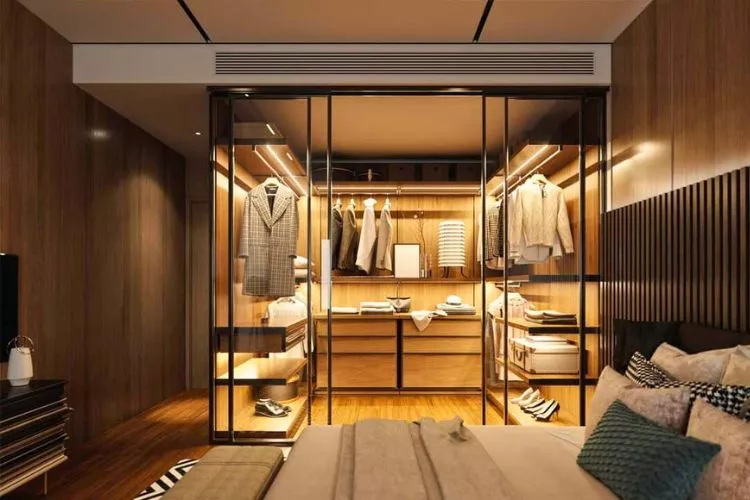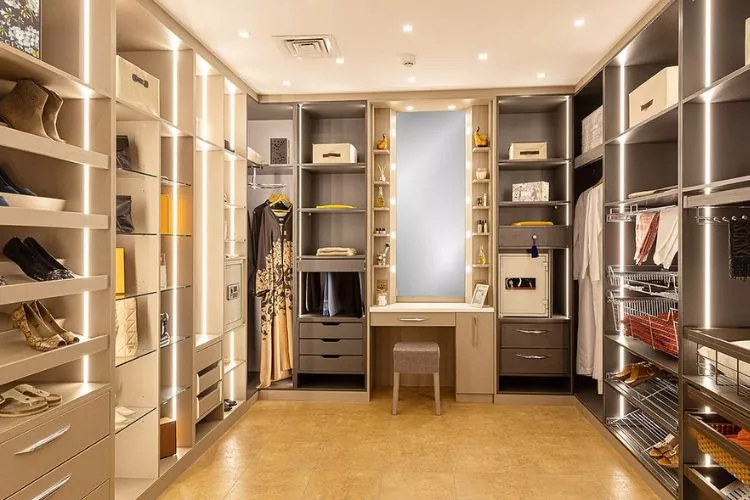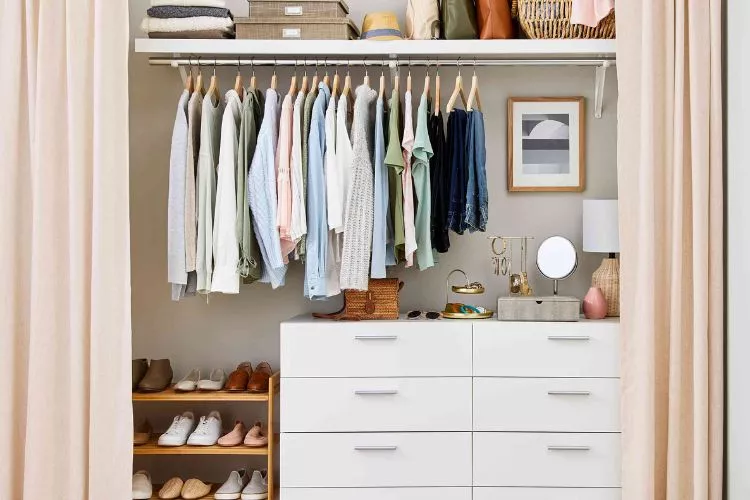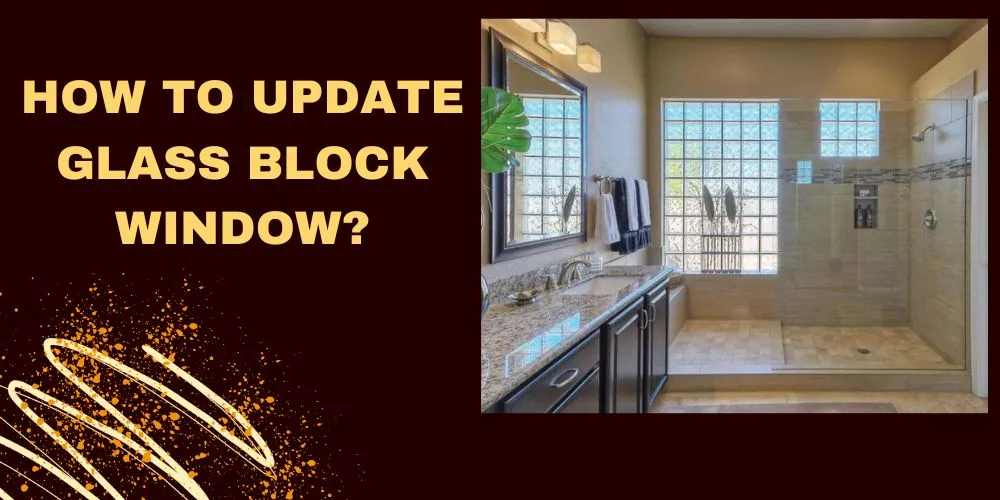In modern interior design, the concept of closets has evolved significantly, raising questions about their traditional components.
This article delves into one of the most debatable aspects: the necessity of a closet door.
So, does a closet have to have a door? Are closet doors mandatory?
Here we investigate the contemporary solutions to this age-old storage conundrum.

Let’s explore the variety of alternatives, their pros and cons, and the impact on aesthetics, organization, and space management.
Does a closet have to have a door?
No, a closet does not necessarily have to have a door. The purpose of a closet is to provide storage and organization, and this can be achieved with or without a door.
Many modern designs have open closets, which provide a showcase for clothing and accessories, lending a boutique-like feel to the room.
However, the decision to have a door or not depends on personal preference and functional requirements. Doors can provide a sense of tidiness, conceal clutter, and offer privacy.
Without doors, closets ensure easy access and visually enlarge the space, creating a more roomy atmosphere.
Therefore, the choice between having a door or not fundamentally comes down to your aesthetic preferences, the room’s layout, and how you intend to use the space.
Do closets need a door?
Closets do not necessarily need a door. The decision to incorporate a door in the closet depends significantly on personal preference, functional needs, and the intended aesthetic of the room.
Open closets have become a popular choice due to their space-saving quality and aesthetic appeal.

At the same time, there are valid reasons for choosing to have a closet door, such as privacy, security, protection of stored items, and maintaining a certain aesthetic.
It is also important to note that in some areas, for a room to be considered a bedroom, it requires the closet to have a door, at least from a real estate perspective.
This is a crucial factor to consider, especially when it comes to home inspections and property value.
Does a Walk-In Closet Need a Door?
A walk-in closet doesn’t necessarily need a door. Much like standard closets, the decision largely depends on personal preferences and the specifics of the room’s layout.
The presence of a door can ensure privacy and help keep dust and light from reaching your clothes.
However, many homeowners opt for an open design to create a feeling of spaciousness and to provide easy accessibility to the contents of the closet.
Do Most Walk-In Closets Have Doors?
While there is no clear consensus on whether most walk-in closets have doors, traditionally, many such closets do feature a door for increased privacy, security, and protection of belongings from dust and light exposure.
However, as home designs evolve, the trend towards doorless or open-concept closets, including walk-in closets, is on the rise.

This is mainly due to aesthetics and the desire to create an open, spacious, boutique-like experience in the closet. Ultimately, the decision to include a door in a walk-in closet largely depends on the user’s needs, preferences, and the overall design of the home.
Do Closet Doors Increase Home Value?
While the presence of closet doors themselves might not directly affect the overall home value, the quality and functionality of closets certainly do. For example, appealing, spacious, and functional closets can increase a home’s resale value.
It isn’t necessarily the door on the closet that impacts value, but the convenience and functionality the entire closet system brings. Potential buyers generally consider closet space and organization as significant factors.
It’s also important to keep in mind the regional preferences as in some areas, a room to be considered a bedroom for real estate purposes, it might require the closet to have a door.
Why Do People Take Doors Off Closets?
There are several reasons why people may choose to remove doors from closets. The primary reason usually revolves around aesthetics and space considerations. Removing doors can create an open, spacious feel, particularly valuable in smaller or cramped spaces.

Many find that having an open closet gives the room a modern, stylish look that mimics a boutique-like experience. Secondly, it can be a functional decision.
Doors can sometimes impede access, especially in tight spaces where they can’t fully open. Removing the doors can thus offer easier, full access to the contents of the closet.
Closet door alternatives
While classic hinged doors or sliding doors are common options for closets, there are several creative and functional alternatives available that can add unique personality to your closet and overall room design.
- Curtains: Curtains are one of the most common alternatives to traditional closet doors. They are cost-effective, easy to install, and offer a wide variety of fabric options, colors, and patterns to match your room décor. Curtains can be opened or closed quickly for easy access and offer a soft, flowing aesthetic appeal.
- Sliding Barn Doors: Sliding barn doors offer a rustic appeal and save space as they slide horizontally, eliminating the need for swing-out clearance. They are robust, stylish, and can be used as a significant design feature in the room.
- Folding Doors: Often made from lightweight materials like vinyl or wood, folding doors or ‘bi-fold’ doors can be folded and pushed aside for full access to the closet’s contents. They’re an excellent alternative for small spaces.
- Room Dividers: Decorative room dividers or folding screens can act as an ideal makeshift door. It’s a flexible option that can be moved as needed and also provide a design statement in the room.
- Beads and Strings: For a bohemian or eclectic vibe, consider beaded or string curtains. They won’t offer much privacy but they certainly contribute to the overall aesthetic feel and provide immediate access to the closet.
- Open Concept: Another popular choice is simply to have no door – an open-concept closet. This method creates a sense of openness and space, but requires you to keep your closet well-organized, as it is always visible.
Picking the perfect closet door alternative is not just about design but also functionality. Consider the closet’s location, size, and the room’s overall style when selecting an appropriate alternative.
Conclusion:
A closet doesn’t necessarily need a door. The choice largely depends on individual preference, functional requirements, and aesthetic considerations.
While closet doors can offer privacy, minimize clutter, and protect belongings from dust and light, doorless closets offer easy access, enhance the feeling of space, and can contribute to a modern room design.
Therefore, whether your closet should have a door essentially rests upon your needs, the room’s layout, your tastes, and how you plan to use the space.


